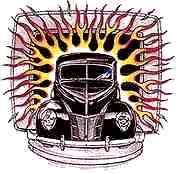

The home of Australian Hot Rodding on the Net
Step 14: WiringTheir are a number of companies now that offer wiring looms for street rods or you can get your auto electrical to custom make one for you. If your feeling adventurous, this is certainly something that you can do at home. With a minimum of specialist tools and some time and patience you can do it your self. Either installing a pre made loom or a loom out of a wreck that suits your purpose. At least you will know where to look when something goes wrong. It is strongly recommended that if you are building you own loom to at least follow some of the basic convention of a popular vehicle, then if someone else ever has to work on the car they won't be starting from scratch. There are some classic stories of cars being wired by novice electricians with wires all the one colour, maybe because they matched the colour of the car. When something went wrong each wire had to be traced and tagged before any work could begin. Wiring is best left to after the car is painted, the wires can be run before the upholstery is fitted and hidden inside or underneath panels as the car goes back together. It's a good idea to include wiring for additional accessories even though you may not be installing them now as to change the loom later is a major undertaking. It's a good idea to run the loom in some sort of conduit where possible to protect the individual wires. AlternatorIf possible buy a new alternator or if using one from a wreck get it checked out before bolting it on. The higher the output the better. The old Chev alternators were only 35amps and these days with all the accessories found in the modern hot rod this is just not enough. Depending upon the motor and the body style you may have to purchase a new alternator mount. These are either a high mount or low mount style. Depending where the room is, the low mount is preferred as it hides the alternator out of the way. GeneratorIf your really keen on the old time look you will want to run a generator. These are not high output devices and unless you really want one you should steer clear of them. InstrumentsThere are many alternatives here from getting your original gauges restored and converted, to reproduction and finally to aftermarket and performance gauges. These days there's even nostalgia replacement, with the alburn dash and instruments or Stewart Warner or even Smiths. It all depends on the style you want and your wallet. SwitchesYou can spend quite a bit of money on aftermarket gauges. And sometimes these switches may not be up to the heavy duty use of your rod. By far better value can be to use the same switches as found in the donor car. This can be very easy when using the same steering column as most modern columns also mount switches for lights, wipers, etc. FusesInstall the fuse box in an easy to get to location and make sure that all accessories are using a fuse. This will save overheated wires or even worse, a fire as the fuse will blow before destroying the wire. HeadlightsMany hot rods use original lighting buckets and bracketry. But there are just as many that use aftermarket units like Dietz and XXX. It really depends on the look you want. If your using original lights as found on 20's and 30's cars they will probably either have to have the reflectors restored andre-chromedd or converted to Quartz Halogen globes and /or bulbs. The headlights found on commercial vehicle were generally a larger version of the passenger models. The can provide their own almost comical look. The cost of repairing you old lights will usually be more than that of buying a new set. Tail LightsThis is another area where a rodder gets to show his or her individual flair. Many rods are fitted with original taillights. But there are just as many that use either a taillight from another make or model. Or custom lights fitted to compliment the contours of the bodywork. There are some classic all time favorite taillights, the '39 Ford TearDrop probably being the most popular, the '40 Chev rectangular style and the timeless Pontiac round lights. IndicatorsMost cars of the 20's, 30's and 40's didn't have indicators. So what ever you fit will be considered to be aftermarket. But you can get some indicators that have just right look, like the Harley style. When it come to indicators it's usually the smaller the better, the smallest size being determined by the registration authorities. In the 70's the big thing was to use motorcycle indicators, but since then these small custom lights have become very popular. There's also many billet and custom styles to compliment tail and stop lights. |
|
Last Updated: 11/08/2002. Copyright © 1996-2004 by
GMW Consulting Services Pty Ltd, all rights reserved. All other trademarks, tradenames and/or service marks are the property of their respective holders. Copyright © 1996-2004 Hot-Rod Internet All Rights Reserved. Please read our Disclaimer , Terms and Conditions and Privacy Policy |